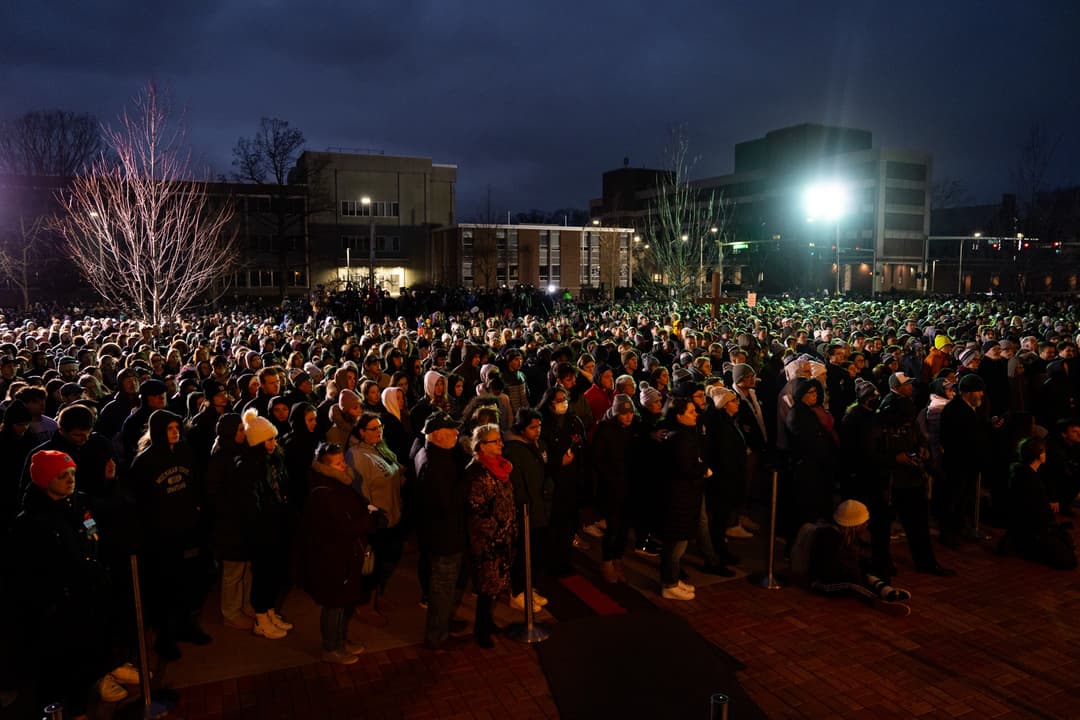Sculptor Austen Brantley discusses solo exhibit ‘Musé,’ being tapped for Michigan Black history projects
Feb 2, 2023
Growing up, Detroit-based sculptor Austen Brantley wanted to play football more than anything else. That was until one day when he found his voice in ceramics class and in creating sculptures out of clay. Now, he’s creating solo exhibitions of his work, like his latest exhibit “Musé” at the Carr Center Gallery in Midtown through Feb. 25, 2023.
The exhibit features clay sculptures, paintings and drawings of women with influences from African American culture and the African diaspora. Brantley will be at his Carr Center Gallery exhibit for an in-person artist talk on Feb. 24.
One Detroit contributor Cecelia Sharpe, of WRCJ 90.9 FM, caught up with Brantley at his studio space in the Russell Industrial Center to talk about “Musé,” two upcoming works dedicated to Michigan’s African American history he’s working on, and how he communicates through his artwork.
Brantley talks about the inspiration and influence he finds from strong Black women and African artwork, as well as two major sculptures he’s creating of Henry and Elizabeth Hamer, the first African Americans to buy land in Royal Oak in 1857, and the former Detroit Tuskegee Airman Lt. Col. Alexander Jefferson, which will be displayed in Rouge Park once completed.
Full Transcript:
Cecelia Sharpe, Host, WRCJ 90.0 FM: Austen! Wow.
Austen Brantley, Sculptor: This is a piece in progress. The piece is pretty much done.
Cecelia Sharpe: And how long did you say you worked on this?
Austen Brantley: I worked on this for about probably 4 hours at this point.
Cecelia Sharpe: Only 4 hours to create this much detail.
Austen Brantley: Took me ten years, though, to learn. How to do it in 4 hours.
Cecelia Sharpe: Right.
Austen Brantley: This is a piece that’s in my new series called “Muse”. And what I’m trying to say with it is, I’m trying to express something about womanhood. That’s a dogon mask from Africa that I transferred into Clay. The reason for that is I feel like African tribes still speak within someone. The figures act as almost thoughts, or people or loved ones in your family, people that you carry with you throughout your life.
And I think about people being landscapes in a way because I feel like the most impactful people in my life have been very strong black women. And the fact that I can get inspired from that and think about them as almost like a landform for me to have made a life on. I think about my work being that too, in a way, like a metaphor. So, the figures kind of emerges from the hair.
Cecelia Sharpe: Is that you?
Austen Brantley: Yeah, that is me.
Cecelia Sharpe: That is you on top. Okay. Wow! You have two major pieces coming up. The piece that honors African Americans, Henry and Elizabeth Hamer. They were the first African-Americans to buy land in Royal Oak and live there in 1857 before Royal Oak was a village. And then, you’re also creating a statue for Detroit Tuskegee Airman, Alexander Jefferson, which will be unveiled maybe next year, 23/24 in Rouge Park. How does it feel as an African American sculptor, from right here in Michigan, to be able to create two pieces that honor African-American legends that are from Michigan?
Austen Brantley: It’s a huge honor. And also it’s a huge responsibility. So, I wake up knowing that what I’m going to do affects people in the future. It’s a lot of work to imagine what needs to be there. And my voice as an artist is always about kind of making a statement, trying to make something that’s going to– that people can relate to after I’m gone. When there’s artwork that makes us think, makes us inspired, and gives us something to reflect on, history is the best thing for that.
Cecelia Sharpe: Talk about how you got started because it started with a ceramics class. What was your introduction into sculpting?
Austen Brantley: I remember the first day I had ceramics and I remember taking it as an easy A. I really wanted to just play football with my friends and I wanted to kind of just wanted to fit in more in school. I didn’t like standing out. And I remember the first day, I thought the clay was so dirty, I want to switch to another class. I was like, I need another art class or something. We had this assignment to make pinch pots, where we take balls of clay and we pinch it to create these little vessels. And I tried that out. It was kind of pretty therapeutic, actually, touching the clay. I thought it was dirty at first and I didn’t want to.
Cecelia Sharpe: Did you take your gloves off?
Austen Brantley: I didn’t take my gloves off while I was doing that. But then, eventually, I took my gloves off when I started just playing around making faces. Maybe after a couple of months, we had our first assignment where we could do whatever we wanted, and I drew a figure sitting on a rock. And I remember my teacher could not believe that I made this thing. He saw me draw it out and then I made it in real life. And I remember that day, that’s when– he loved the sculpture more than me.
He picked it up and then he had this graceful way of showing that you did something right, and he would hold it above his head, and walk around slowly in the class. So, in talking about the work and why it’s important, talking about the things that you did right, and he did that for every student that did it, it didn’t matter who you were. If you did something right, it was special. I think it really put me on the journey because when a kid receives that praise for something that he did and no one else has given it to him, that means the world to someone, to a child, I think.
I feel like I have this, when I wake up, I feel like I have this yearning to express something and say something. And I’m not a loud person. I think a lot of people would say that I’m quiet. The truth is, I don’t think I’m quiet. I think I just need another way of saying something. I’ve been told that my work is quiet but loud. That’s something to be said about making artwork and about knowing yourself as a person, is that even if you’re a quiet person, you can speak through something else and say what you need to say.
For me, the way I get inspired is by taking trips to different countries, and weird cities, and getting lost within them, and meeting cool people, and doing interesting things. That’s what really fuels me as an artist and a person. It gives me the drive to create something. I have solo exhibits that are based around experiences that I have when I travel to different countries.
So, when I’m traveling to a different country, I’ll write about it and I’ll journal my experience. I’ll try and reflect on the trip as a whole. And maybe something that I learned on that trip will become this one mantra. It Will become the title for an exhibition, and then a whole series of works will be created for that title. So, the work almost feels like a journal at that point.
Stay Connected:
Subscribe to One Detroit’s YouTube Channel & Don’t miss One Detroit Mondays and Thursdays at 7:30 p.m. on Detroit PBS, WTVS-Channel 56.
Catch the daily conversations on our website, Facebook, Twitter @DPTVOneDetroit, and Instagram @One.Detroit
View Past Episodes >
Watch One Detroit every Monday and Thursday at 7:30 p.m. ET on Detroit Public TV on Detroit Public TV, WTVS-Channel 56.
Stay Connected
Subscribe to One Detroit’s YouTube Channel and don’t miss One Detroit on Thursdays at 7:30 p.m. and Sundays at 9 a.m. on Detroit PBS, WTVS-Channel 56.
Catch the daily conversations on our website, Facebook, Twitter @OneDetroit_PBS, and Instagram @One.Detroit
Related Posts
Leave a Reply
Your email address will not be published. Required fields are marked*




























